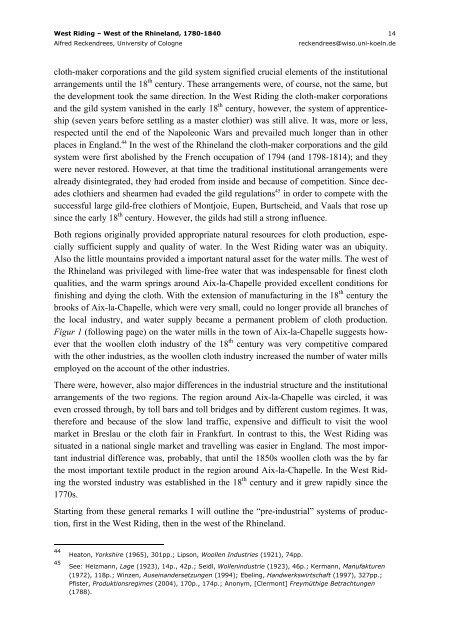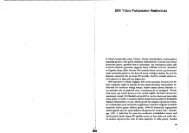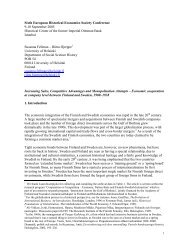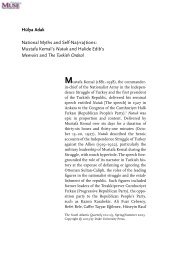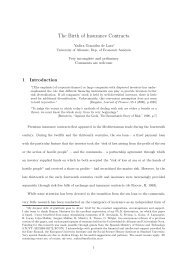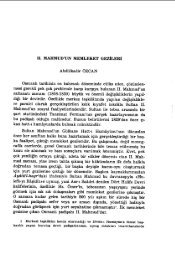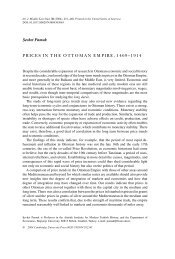West Riding – Western Rhineprovince, 1790-1840: Diverse Paths to ...
West Riding – Western Rhineprovince, 1790-1840: Diverse Paths to ...
West Riding – Western Rhineprovince, 1790-1840: Diverse Paths to ...
Create successful ePaper yourself
Turn your PDF publications into a flip-book with our unique Google optimized e-Paper software.
<strong>West</strong> <strong>Riding</strong> <strong>–</strong> <strong>West</strong> of the Rhineland, 1780-<strong>1840</strong> 14<br />
Alfred Reckendrees, University of Cologne reckendrees@wiso.uni-koeln.de<br />
cloth-maker corporations and the gild system signified crucial elements of the institutional<br />
arrangements until the 18 th century. These arrangements were, of course, not the same, but<br />
the development <strong>to</strong>ok the same direction. In the <strong>West</strong> <strong>Riding</strong> the cloth-maker corporations<br />
and the gild system vanished in the early 18 th century, however, the system of apprenticeship<br />
(seven years before settling as a master clothier) was still alive. It was, more or less,<br />
respected until the end of the Napoleonic Wars and prevailed much longer than in other<br />
places in England. 44 In the west of the Rhineland the cloth-maker corporations and the gild<br />
system were first abolished by the French occupation of 1794 (and 1798-1814); and they<br />
were never res<strong>to</strong>red. However, at that time the traditional institutional arrangements were<br />
already disintegrated, they had eroded from inside and because of competition. Since decades<br />
clothiers and shearmen had evaded the gild regulations 45 in order <strong>to</strong> compete with the<br />
successful large gild-free clothiers of Montjoie, Eupen, Burtscheid, and Vaals that rose up<br />
since the early 18 th century. However, the gilds had still a strong influence.<br />
Both regions originally provided appropriate natural resources for cloth production, especially<br />
sufficient supply and quality of water. In the <strong>West</strong> <strong>Riding</strong> water was an ubiquity.<br />
Also the little mountains provided a important natural asset for the water mills. The west of<br />
the Rhineland was privileged with lime-free water that was indespensable for finest cloth<br />
qualities, and the warm springs around Aix-la-Chapelle provided excellent conditions for<br />
finishing and dying the cloth. With the extension of manufacturing in the 18 th century the<br />
brooks of Aix-la-Chapelle, which were very small, could no longer provide all branches of<br />
the local industry, and water supply became a permanent problem of cloth production.<br />
Figur 1 (following page) on the water mills in the <strong>to</strong>wn of Aix-la-Chapelle suggests however<br />
that the woollen cloth industry of the 18 th century was very competitive compared<br />
with the other industries, as the woollen cloth industry increased the number of water mills<br />
employed on the account of the other industries.<br />
There were, however, also major differences in the industrial structure and the institutional<br />
arrangements of the two regions. The region around Aix-la-Chapelle was circled, it was<br />
even crossed through, by <strong>to</strong>ll bars and <strong>to</strong>ll bridges and by different cus<strong>to</strong>m regimes. It was,<br />
therefore and because of the slow land traffic, expensive and difficult <strong>to</strong> visit the wool<br />
market in Breslau or the cloth fair in Frankfurt. In contrast <strong>to</strong> this, the <strong>West</strong> <strong>Riding</strong> was<br />
situated in a national single market and travelling was easier in England. The most important<br />
industrial difference was, probably, that until the 1850s woollen cloth was the by far<br />
the most important textile product in the region around Aix-la-Chapelle. In the <strong>West</strong> <strong>Riding</strong><br />
the worsted industry was established in the 18 th century and it grew rapidly since the<br />
1770s.<br />
Starting from these general remarks I will outline the “pre-industrial” systems of production,<br />
first in the <strong>West</strong> <strong>Riding</strong>, then in the west of the Rhineland.<br />
44 Hea<strong>to</strong>n, Yorkshire (1965), 301pp.; Lipson, Woollen Industries (1921), 74pp.<br />
45 See: Heizmann, Lage (1923), 14p., 42p.; Seidl, Wollenindustrie (1923), 46p.; Kermann, Manufakturen<br />
(1972), 118p.; Winzen, Auseinandersetzungen (1994); Ebeling, Handwerkswirtschaft (1997), 327pp.;<br />
Pfister, Produktionsregimes (2004), 170p., 174p.; Anonym, [Clermont] Freymüthige Betrachtungen<br />
(1788).


